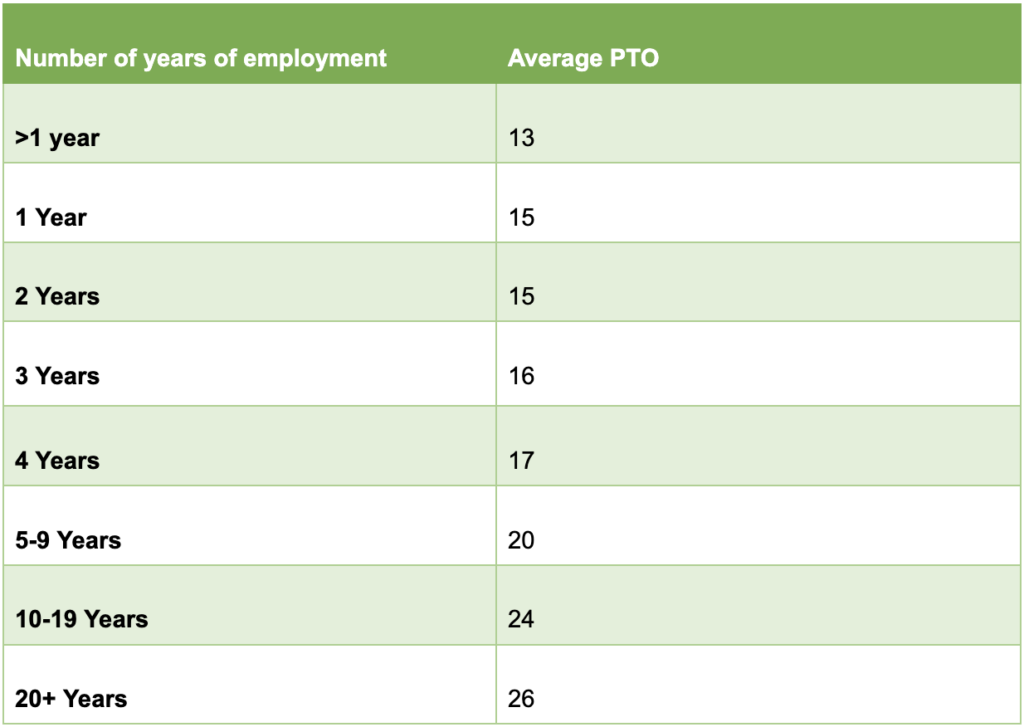How Much Paid Time Off (PTO) are US Employees Entitled To
Feb 17, 2023 • 5 min read
Paid Time Off (PTO) is also know as personal time off or vacation days and is the number of days employees are allowed to take off for any reason with pay. This does not include sick days or public holidays. PTO can be used for vacations, family time, mental health purposes and so on, it’s up to the employee how they want to spend these days.
While US federal law doesn’t dictate a set amount of PTO, it is highly encouraged that businesses offer a competitive number of PTO days. Not only does offering PTO help to retain your current employees, but it also makes open positions and working for your company a lot more appealing. PTO is a great motivator for your team and can have a significant impact on productivity. Many businesses choose to calculate PTO based on the number of years an employee has been with them.
You’ll learn:
- What is the average PTO in the US?
- Does Industry have an impact on PTO?
- The differences in average PTO according to US states
- How does average PTO in the US compare to the rest of the world?.
- What’s the best PTO policy for your business?
Ready to build your remote team?
Use the DigiWorks platform to hire, manage, and pay remote talent from all over the world.
What is the average PTO in the US?
According to statistics from Zippia, the average number of PTO days in the United States private sector is 10 days. Most employers in the private sector tend to offer between 5 and 15 PTO days every year. Years of services and total number of working hours are usually considered for this calculation. According to information from the US Bureau of Labour Statistics, 46% of full-time employees have access to consolidated leave plans while only 35% of part-time employees have access to the aforementioned plans.
PTO in relation to duration of employment

Research also suggests that age plays a big difference in PTO, with employees between the ages of 18 and 24 receiving average PTO of 6.2 days a year and employees over the age of 65 receiving 13+ days of PTO a year.
Does Industry have an impact on PTO?
The short answer to this question is yes. There are significant differences in the number of days employees receive in different industries, while technical fields receive the highest number of PTO, employees in the service sector receive the fewest.
The industries with the most PTO days a year are:
- Non-Profit / Foundation with an average of 17.5 days a year
- Government / Military with an average of 17.3 days a year
- Utilities with an average of 15.8 days a year
The industries that reported the fewest PTO days a year are:
- Advertising – with an average of 3.3 days a year
- Mining – with an average of 2.0 days a year
- Marketing / Market Research / Public Relations – with an average of 0.0 days a year
The differences in average PTO according to US states
PTO varies throughout the US as there is no legislation that requires a specific minimum PTO and greatly leaves this up to business owners to determine. States with a higher number of competitive jobs tend to offer more PTO to attract more candidates for their openings while the opposite is true for states with fewer competitive jobs.
Southwest and Northeast regions offer PTO that is higher than the national average of 10 days.
The Southwest region includes Arizona, New Mexico, Texas, Oklahoma, and the average PTO for these states is 10.3 days a year.
The Northeast region includes Maine, New York, Massachusetts, Rhode Island, New Hampshire, Vermont, Connecticut, Delaware, New Jersey, Pennsylvania, and the average PTO for these states is 11.4 days a year.
Meanwhile, the Southeast and Midwest regions offer PTO that is lower than the national average of 10 days.
The Southeast region includes West Virginia, DC, Carolinas, Virginia, Tennessee, Arkansas, Louisiana, Alabama, Florida, Georgia, Kentucky, Maryland, and the average PTO for these states is 8.5 days a year.
The Midwest region includes Kansas, Nebraska, South Dakota, North Dakota, Missouri, Iowa, Minnesota, Michigan, Illinois, Ohio, Wisconsin, Indiana, and the average PTO for these states is 8.5 days a year.
If you’re looking for more PTO, you should consider heading either southwest or northeast!

How does average PTO in the US compare to the rest of the world?
The European Union requires all countries within its union to offer 4 weeks of paid vacation every year, in contrast the US does not have any laws that dictate required PTO. The list below shows the countries that offer the highest average PTO worldwide.
- Austria – Average PTO of 24 days a year
- Portugal – Average PTO of 24 days a year
- Germany – Average PTO of 24 days a year
- Spain – Average PTO of 22 days a year
- France – Average PTO of 30 days a year
The numbers listed above are only PTO or vacation days, this does not include public holidays and sick days which significantly increases the total number of days employees can take off a year. In comparison, the US comes in at less than half the PTO of these European countries.
What’s the best PTO policy for your business?
There’s a lot of debate surrounding PTO as the US is one of three most productive countries worldwide in terms of GPD per capita but offers the least average PTO when compared to the other top three countries. Some argue that offering less PTO increases productivity simply by clocking more productive hours and the other side of debate argues that offering more PTO and benefits increases individual productivity and company loyalty. So, this one is really dependent on your company culture and what you want to prioritize. Making use of HR software is a good place to start when drafting your PTO policy and if you’ve really not got the time or energy for HR policies, leaving this to an HR tech platform like DigiWorks can pretty ensure you’re being compliant while still remaining competitive and attractive to new employees. The cool thing about hiring DigiWorks candidates is that their hours, PTO, and timezones are super flexible and amenable to your schedule and policies.
Ready to build your remote team?
Use the DigiWorks platform to hire, manage, and pay remote talent from all over the world.
Related Articles
About DigiWorks
DigiWorks is an easy-to-use platform that helps small businesses and start ups hire amazing remote talent from around the world. DigiWorks offers a way for you to hire, manage and pay people from all countries. If you find an amazing virtual assistant from Philippines, a content writer from Nigeria, or operations manager from South Africa – manage and pay your entire team from one platform with no hassle.
If you’re looking for a more affordable and sustainable option you might consider making use of a hiring platform like DigiWorks. Virtual assistant companies or platforms like DigiWorks are amazing as they not only match you with pre-vetted and assessed remote workers that can take care of all your business needs but they will also handle all onboarding and payroll needs as well.



